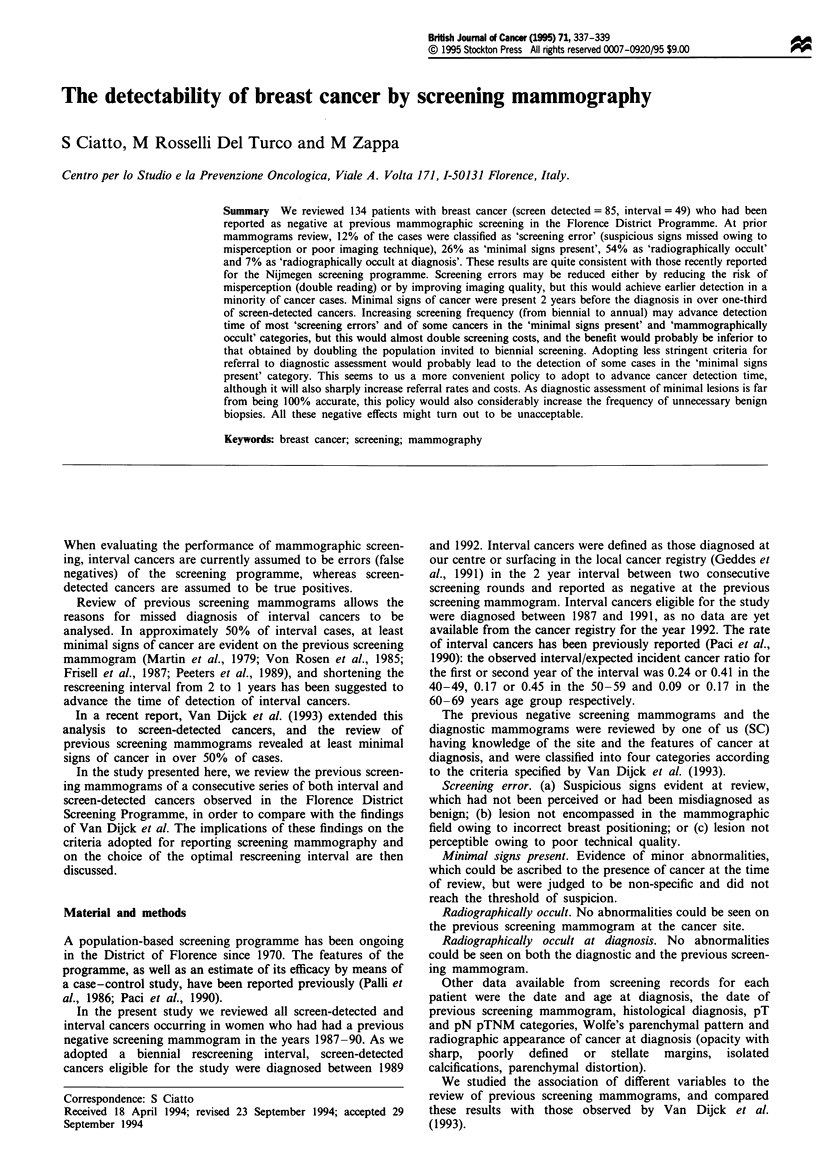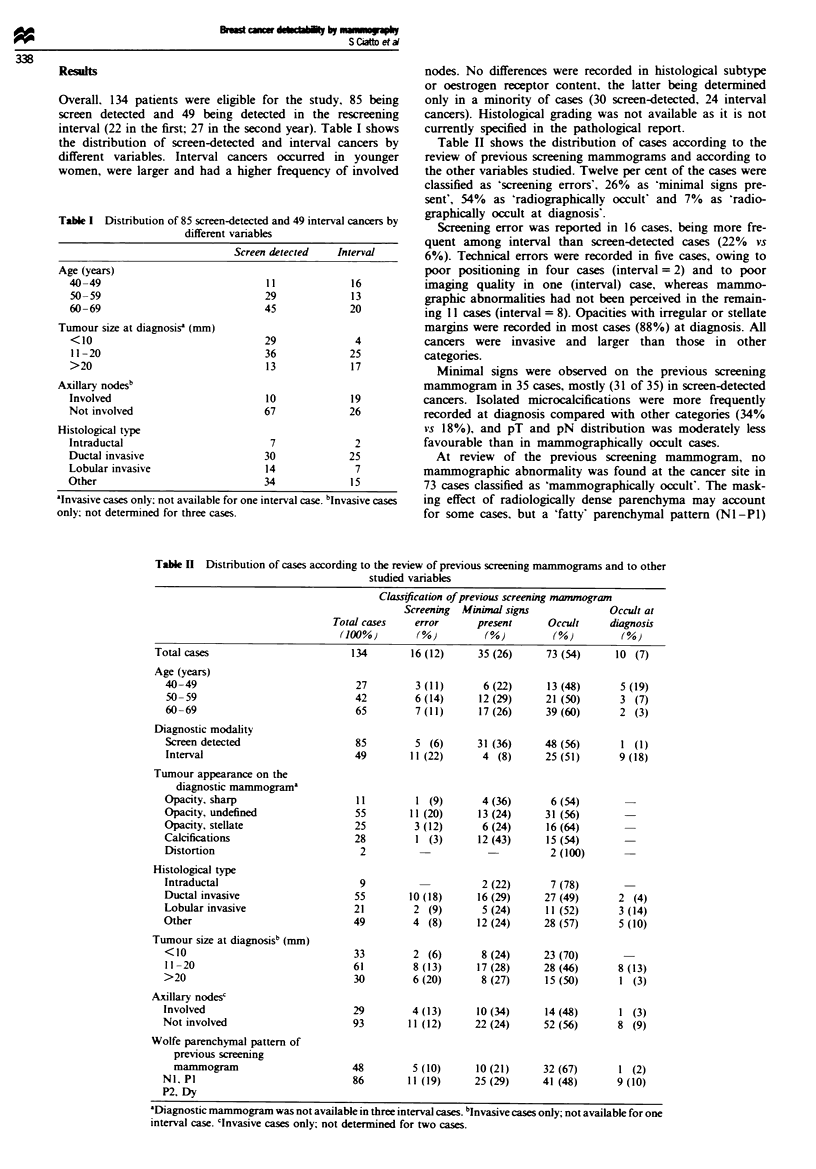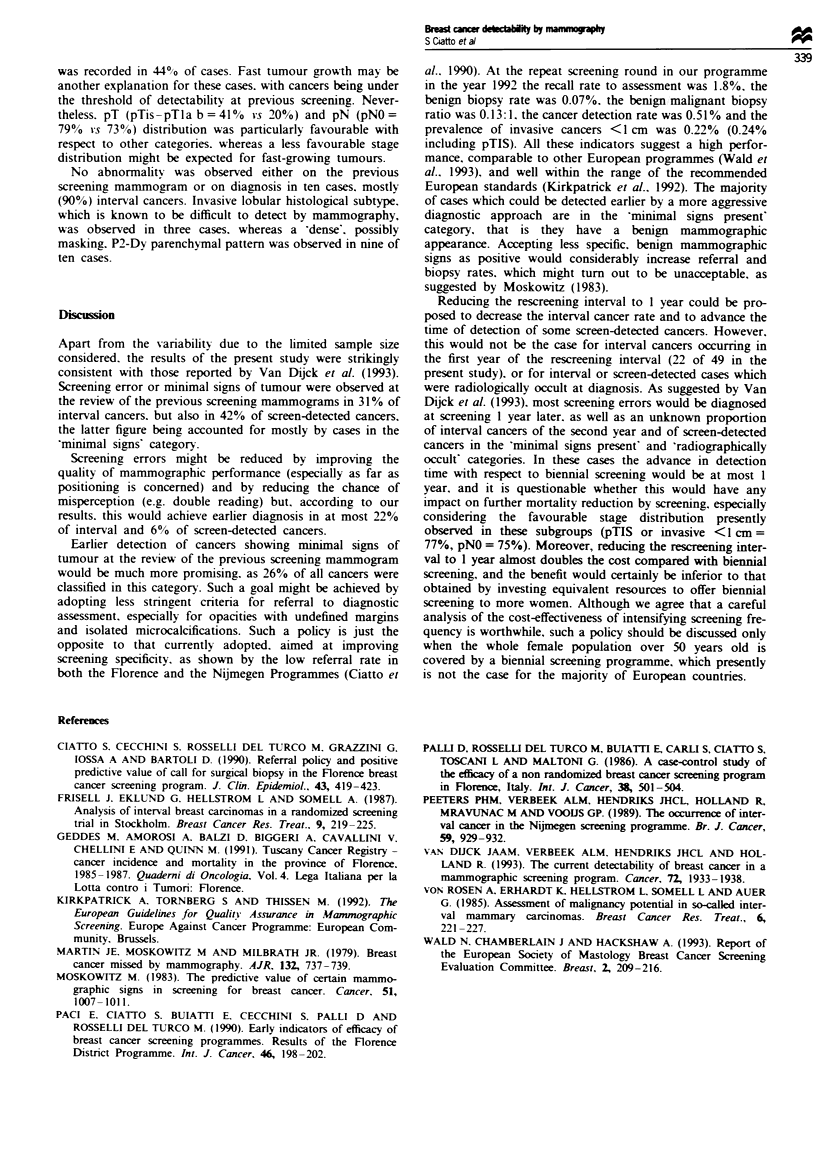Abstract
We reviewed 134 patients with breast cancer (screen detected = 85, interval = 49) who had been reported as negative at previous mammographic screening in the Florence District Programme. At prior mammograms review, 12% of the cases were classified as 'screening error' (suspicious signs missed owing to misperception or poor imaging technique), 26% as 'minimal signs present', 54% as 'radiographically occult' and 7% as 'radiographically occult at diagnosis'. These results are quite consistent with those recently reported for the Nijmegen screening programme. Screening errors may be reduced either by reducing the risk of misperception (double reading) or by improving imaging quality, but this would achieve earlier detection in a minority of cancer cases. Minimal signs of cancer were present 2 years before the diagnosis in over one-third of screen-detected cancers. Increasing screening frequency (from biennial to annual) may advance detection time of most 'screening errors' and of some cancers in the 'minimal signs present' and 'mammographically occult' categories, but this would almost double screening costs, and the benefit would probably be inferior to that obtained by doubling the population invited to biennial screening. Adopting less stringent criteria for referral to diagnostic assessment would probably lead to the detection of some cases in the 'minimal signs present' category. This seems to us a more convenient policy to adopt to advance cancer detection time, although it will also sharply increase referral rates and costs. As diagnostic assessment of minimal lesions is far from being 100% accurate, this policy would also considerably increase the frequency of unnecessary benign biopsies. All these negative effects might turn out to be unacceptable.
Full text
PDF


Selected References
These references are in PubMed. This may not be the complete list of references from this article.
- Ciatto S., Cecchini S., del Turco M. R., Grazzini G., Iossa A., Bartoli D. Referral policy and positive predictive value of call for surgical biopsy in the Florence Breast Cancer Screening Program. J Clin Epidemiol. 1990;43(5):419–423. doi: 10.1016/0895-4356(90)90129-d. [DOI] [PubMed] [Google Scholar]
- Frisell J., Eklund G., Hellström L., Somell A. Analysis of interval breast carcinomas in a randomized screening trial in Stockholm. Breast Cancer Res Treat. 1987;9(3):219–225. doi: 10.1007/BF01806383. [DOI] [PubMed] [Google Scholar]
- Martin J. E., Moskowitz M., Milbrath J. R. Breast cancer missed by mammography. AJR Am J Roentgenol. 1979 May;132(5):737–739. doi: 10.2214/ajr.132.5.737. [DOI] [PubMed] [Google Scholar]
- Moskowitz M. The predictive value of certain mammographic signs in screening for breast cancer. Cancer. 1983 Mar 15;51(6):1007–1011. doi: 10.1002/1097-0142(19830315)51:6<1007::aid-cncr2820510607>3.0.co;2-p. [DOI] [PubMed] [Google Scholar]
- Paci E., Ciatto S., Buiatti E., Cecchini S., Palli D., Rosselli del Turco M. Early indicators of efficacy of breast cancer screening programmes. Results of the Florence District Programme. Int J Cancer. 1990 Aug 15;46(2):198–202. doi: 10.1002/ijc.2910460209. [DOI] [PubMed] [Google Scholar]
- Palli D., Del Turco M. R., Buiatti E., Carli S., Ciatto S., Toscani L., Maltoni G. A case-control study of the efficacy of a non-randomized breast cancer screening program in Florence (Italy). Int J Cancer. 1986 Oct 15;38(4):501–504. doi: 10.1002/ijc.2910380408. [DOI] [PubMed] [Google Scholar]
- Peeters P. H., Verbeek A. L., Hendriks J. H., Holland R., Mravunac M., Vooijs G. P. The occurrence of interval cancers in the Nijmegen screening programme. Br J Cancer. 1989 Jun;59(6):929–932. doi: 10.1038/bjc.1989.196. [DOI] [PMC free article] [PubMed] [Google Scholar]
- van Dijck J. A., Verbeek A. L., Hendriks J. H., Holland R. The current detectability of breast cancer in a mammographic screening program. A review of the previous mammograms of interval and screen-detected cancers. Cancer. 1993 Sep 15;72(6):1933–1938. doi: 10.1002/1097-0142(19930915)72:6<1933::aid-cncr2820720623>3.0.co;2-n. [DOI] [PubMed] [Google Scholar]
- von Rosen A., Erhardt K., Hellström L., Somell A., Auer G. Assessment of malignancy potential in so-called interval mammary carcinomas. Breast Cancer Res Treat. 1985;6(3):221–227. doi: 10.1007/BF01806772. [DOI] [PubMed] [Google Scholar]


